![]()
![]()
![]()
Use LEFT and RIGHT arrow keys to navigate between flashcards;
Use UP and DOWN arrow keys to flip the card;
H to show hint;
A reads text to speech;
100 Cards in this Set
- Front
- Back

A weighted fin that, when attached to the bottom of a sailboat, keeps the boat from slipping sideways in the water and allows it to sail upwind. |
keel
|
|
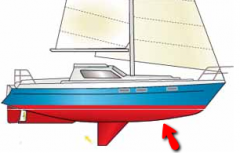
The boat minus the rigging, includes bottom, topsides, buoyancy tanks, and eck.
|
hull
|
|
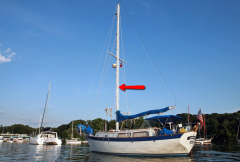
The vertical pole or spar that supports the sails and boom.
|
mast
|
|
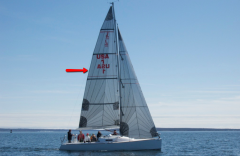
The primary and most easily controlled source of sail power, attached along the front (aft) side/edge of the mainmast and along the bottom edge to the boom.
|
mainsail
|
|
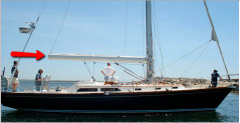
The horizontal spar which is attached to the mast to support the bottom part of the mainsail. |
boom
|
|
|
The front of the boat.
The forward part of the boat. |
bow
|
|
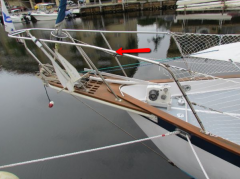
A guardrail around the bow of the boat which is usually used to aid a crew in mooring or anchoring.
|
bow pulpit
|
|
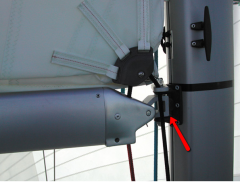
The swivel connection (articulated fitting) connecting boom to mast. The boom moves from side to side and up and down by swiveling on it. |
gooseneck
|
|
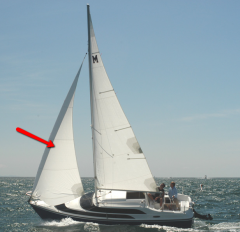
A triangular sail set forward of the mainmast.
|
jib
|
|
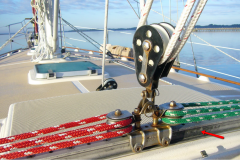
A slide, running across the boat, to which the mainsheet is led. The crew can adjust the trim of the mainsail by adjusting the slide position. |
traveler
|
|
|
The back of the boat
|
stern
|
|
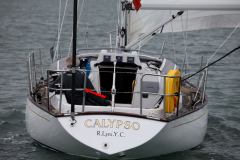
A sturdy railing around the deck at the stern |
stern pulpit
|
|
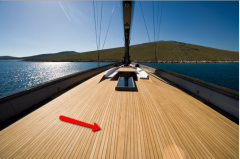
The horizontal upper surface of the boat.
|
deck
|
|
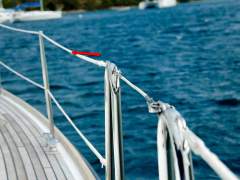
Lines attached to the stanchions to help prevent the crew from going overboard.
|
lifelines
|
|
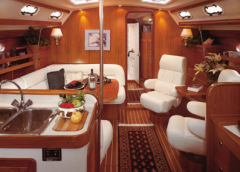
A compartment for passengers or crew. |
cabin
|
|
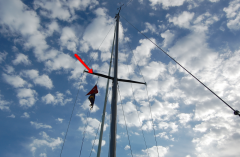
Horizontal spars which spread the shrouds from the mast.
|
spreaders
|
|
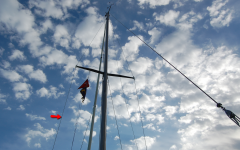
Wires that run from the masthead (or near the masthead) to the sides of the boat to support the mast and prevent it from swaying
|
shrouds
|
|
|
A wire that runs from the top of the mast (or near the masthead) to the bow and onto which the jib is attached. It supports the mast preventing it from falling backwards. |
headstay
|
|
|
a piece of standing rigging which keeps a mast from falling backwards. It is attached either at the very top of the mast, or in fractional rigs between about 1/8 and 1/4 from the top of the mast. The other end of the forestay is attached to the bow of the boat. |
forestay
|
|
|
A line or cable which supports the mast from the stern of the boat.
|
backstay
|
|
|
A line used to trim the mainsail; it is led through a series of blocks to form a block and tackle. |
mainsheet
|
|
|
The fin at the stern of the boat used for steering
|
rudder
|
|
|
The wooden or metal steering arm attached to the rudder. It is used as a lever to turn the rudder. |
tiller |
|
|
On larger boats the wheel replaces the tiller and is used to turn the rudder
|
wheel
|
|
|
a line or piston system on a sailboat used to exert downward force on the boom and thus control the shape of the sail. An older term is "martingale".
|
boomvang |
|
|
What are items 2 and 3 |
//fce-studymode.netdna-ssl.com/images/upload-flashcards/front/8/3/34938891_m.jpg 2 are pintles and 3 are gudgeons |
|
|
The shrouds, forestay, and backstay support the mast. The strong metal fittings that attach these wires to the mast are called ...
|
tangs
|
|
|
The shrouds and backstay are attached to the boat with a ...
|
turnbuckle which attaches to the chainplate via the toggle
|
|
|
The masthead light is white and is visible from ahead to an angle of 22.5 degrees abaft the beam on both sides. It indicates ...
|
the boat is moving under engine power. It should be extinguished when the engine is not operating
|
|
|
Unless anchored in a recognized small craft anchorage, all vessels are required to show ...
|
one 360 degree white light
|
|
|
Port side lights are what color:?
|
red
"port wine is red" |
|
|
A sailboat under power will show the following lights...
|
sidelights, masthead light (higher than sidelights), and sternlight
|
|
|
To signal with horn or whistle you plan to pass port to port
|
one short blast
|
|
|
To signal with horn or whistle you plan to pass starboard to starboard
|
two short blasts
|
|
|
To signal with horn or whistle you are operating in reverse
|
three short blasts
|
|
|
To signal with horn or whistle indicating a dangerous situation exists is ...
|
five short blasts
|
|
|
To signal with horn or whistle when a powerboat is leaving dock
|
one prolonged blast
|
|
|
To signal with horn or whistle when approaching a bend or obscured site sound ...
|
one prolonged blast (4-6 seconds)
|
|
|
When should you offer assistance to a boat in distress?
|
always
|
|
|
If a passenger pays for a portion of gas or slip fee your boat is being ...
|
chartered and the skipper must be licensed
|
|
|
A type IV PFD is ...
|
a throwable device, i.e. cushion or ring
|
|
|
What percent of boating fatalities could have been prevented by the wearing of a PFD?
|
80 percent
|
|
|
To "stand on" means...
|
you have the right to hold your course and speed, because you have the right of way.
|
|
|
when two boats are on the same tack, who has the right of way?
|
the leeward boat (the one further downwind) has the right of way.
|
|
|
When boats on same point of sail which has the right of way?
|
The third rule is the "starboard tack rule" when two boats are sailing on different tacks with the same point of sail, the one on a starboard tack has the right of way. The port tack boat must yield.
|
|
|
Fires are classified Class A, B, and C - what does class A represent?
|
Class A: ordinary combustible material such as paper and wood;
|
|
|
Class B Fires?
|
Class B: gasoline, oil, grease, and other flammable liquids;
|
|
|
Class C Fires?
|
electrical fires
|
|
|
Water is suitable for what type of fires?
|
Class A only
|
|
|
When the boat is overpowered with wind, "weather helm" results. What is it?
|
The boat wants to turn itself into the wind.
|
|
|
What is the coastal warning display for "Small craft advisory"? This indicates wind and sea conditions dangerous to small craft.
|
One red pennant displayed by day. One red light above a white light at night.
|
|
|
Who is the stand on boat when one boat is running and the other is close hauled and they are on the same tack?
|
The close hauled boat is stand on since the running boat is to windward.
|
|
|
what is running "wing and wing"
|
Running with mainsail eased out and the jib on the windward side (sails on each side of the boat); also called gull wing or goosewing
|
|
|
What should a sailboat do in a marked shipping channel
|
Cross the channel as quickly as possible perpendicular to the channel.
|
|
|
The hollow, lowermost portion of a ship, floating partially submerged and supporting the remainder of the ship
|
Hull
|
|
|
The surface that forms the stern of a vessel
|
Transom
|
|
|
"Heading Up"
|
STOPPED EDITING HERE CJS
|
|
|
Tacking
|
Tacking or coming about is a sailing maneuver by which a sailing vessel (which is sailing approximately into the wind) turns its bow through the wind so that the direction from which the wind blows changes from one side to the other. In other words, going entirely through the no-sail zone
|
|
|
No Sail Zone
|
The zone in relation to the wind where the sails are unable to generate power. On graphic will be 90 degree wedge (45 degrees on either side of 12 on a clock, or in other words 10:30 to 1:30)
|
|
|
In Irons
|
of a boat that is head to wind, having lost all headway
|
|
|
Luffing
|
Luffing is when the sail is flapping in the wind. It occurs when the sail has been set too far out and needs to be trimmed in
|
|
|
Head-to-Wind
|
A boat's position when its bow is pointing directly into the wind.
|
|
|
Port Tack
|
Any course where wind is blowing on port side of boat.
|
|
|
Starboard Tack
|
Any course where wind is blowing on starboard side of boat.
|
|
|
Close Hauled
|
The point of sail where a boat sails as close to the wind as possible.
|
|
|
Close Reach
|
The point of sail where between close hauled and beam reach.
|
|
|
Beam Reach
|
The point of sail where the wind in abeam of the boat.
|
|
|
Broad Reach
|
The point of sail between beam reach and a run.
|
|
|
Run
|
The point of sail in which the wind is aft.
|
|
|
Sailing-by-the-lee
|
Sailing on a run with the wind on the same side of the boat as the mainsail.
|
|
|
Stand-on
|
Maintaining course and speed...a Stand-on vessel- in a situation when two vessels converge, the vessel must maintain its course and speed.
|
|
|
Give-way
|
Under the Nav rules, the vessel that is obliged to adjust it course or speed to avoid collision with another vehicle.
|
|
|
Jibing
|
Maneuvering the boat to change tacks (the side of the boat upon which the wind blows). In a jibe, the boat turns away from the the wind at the downward side of the points of sail diagram.
|
|
|
"Ready About"
|
Synonymous with "Prepare to Tack" ; Announced when helmsman is sure there is room to for a tack maneuver. The crew then responds "Ready." Helmsman then announces "Tacking" or "helms-a-lee" (Or coming- about ??) to indicate beginning of turn and pushes tiller smoothly to leeward to initiate turn.
|
|
|
"Prepare to Jibe"
|
Helmsman command,
Response by crew = the crew takes a couple of wraps on the winch and when ready, they and the mainsheet trimmer respond by saying "Ready." After everyone gets out of way of mainsheet and below path of boom..helmsman will then say "Jibe-ho" or "Jibing" and begins to turn boat slowly away from wind by pulling tiller toward him or turning the wheel in the direction the boat is to turn |
|
|
"Bearing Away"
|
EXPLAIN COMMAND AND RESPONSE
|
|
|
"Heading Up"
|
Explain Command and Response
|
|
|
Helm
|
Nautical The steering gear of a ship, especially the tiller or wheel.
|
|
|
Tiller
|
Lever used to control the angle of rudder and thereby steer boat
|
|
|
Standing Rigging
|
Rigging (e.g. shrouds and stays, that supports spars and that remains in place when a boat is not sailing.
|
|
|
Shroud
|
A wire that provides athwartships support to the mast.
|
|
|
athwartships
|
Across the boat from side to side
|
|
|
Spreader
|
An athwartships strut on a mast that holds a shroud away from the mast.
|
|
|
Chainplate
|
Metal fabrication attached to the hull and to which a stay or shroud is connected.
|
|
|
Headstay
|
The stay between the top of the mast and the bow
|
|
|
Forestay
|
A stay that supports the mast from forward.
|
|
|
Backstay
|
A wire support from the top of the mast to the stern
|
|
|
Stanchion
|
Metal support for lifelines which are which is a wire around perimeter of boat to prevent crew from falling.
|
|
|
Winch
|
A device consisting of gear driven drum that is operated with a handle to provide mechanical advantage when hauling a line; also used to snub a line.
|
|
|
Cleat
|
A fitting used to secure line under load.
|
|
|
Fender
|
A cushion, usually inflated cylinder or rubber or similar material, placed between a boat and a dock.
|
|
|
Docklines |
Used to tie boat to dock.
|
|
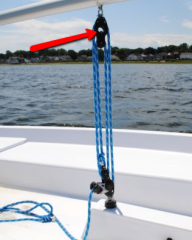
Block |
A pulley.
|
|
|
Fairlead |
A fitting used to lead a line fair and a the correct angle to a winch, cleat, or other sitting.
|
|
|
Cockpit
|
The area of the boat, usually recessed into the deck, from which the boat is steered and sailed.
|
|
|
Cabin
|
Interior of boat.
|
|
|
Pulpit
|
Guardrail at bow or stern of a boat to which lifelines are usually connected. |
|
|
CFR Equip for recreational sailboats over 25 feet. |
Type IV PFD (Thrown) must be on vessels over 16'. |
|
|
Rule 5, or the "look out" rule. |
Every vessel shall at all times maintain a proper lookout by sight and hearing as well as by all available means appropriate in the prevailing circumstances and conditions so as to make a full appraisal of the situation and of the risk of collision. |
|
|
Describe what to do when crew member falls overboard. (COB, Crew Overboard)
|
Anyone who sees it yells Crew/Man Overboard. |

